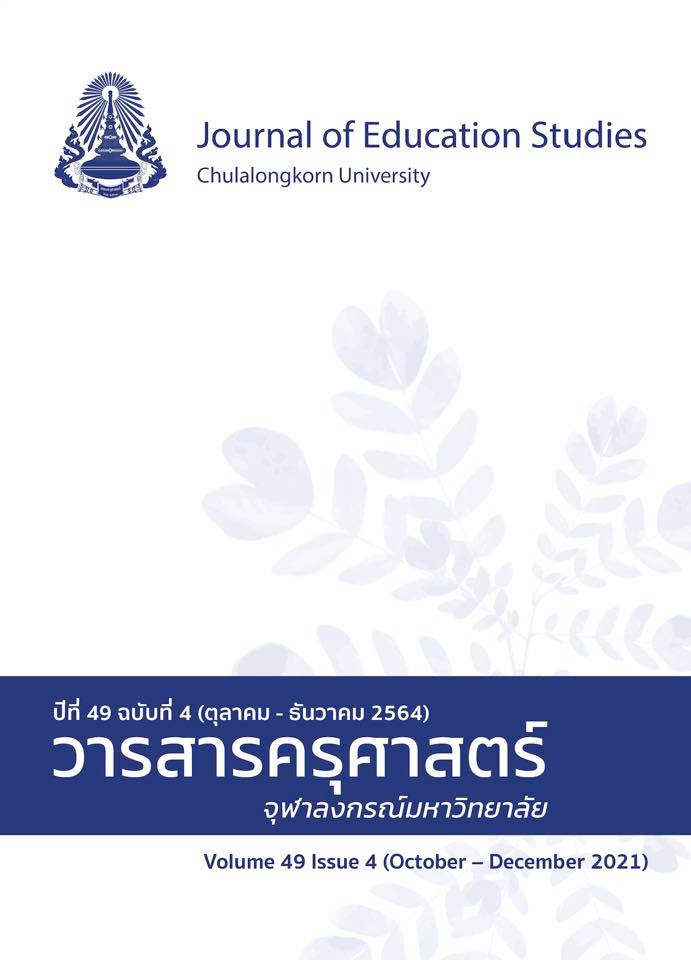A Confirmatory Factor Analysis of Digital Competency for Student Teachers of Rajabhat University
DOI:
https://doi.org/10.14456/educu.2021.61Keywords:
digital competency, student teachers, confirmatory factor analysisAbstract
This research article is part of the research entitled Guidelines for Developing Digital Competency for Student Teachers of Rajabhat University. The purpose of this study was to validate the fitness of digital competency component models for student teachers of Rajabhat University with empirical data. The sample consisted of 900 student teachers of Rajabhat University, selected by multi-stage random sampling. The data were collected by using a 5-point rating scale which the content validity was approved by 5 experts. An index of item-objective congruence ranged from .80 to 1.0. Using Cronbach’s alpha, the reliability of the scale was .991. The data were analyzed by using descriptive statistics and second-order confirmatory factor analysis (CFA). The research findings showed that there were 5 components of the digital competency of student teachers of Rajabhat University i.e., digital literacy, digital usage, the interaction and communication, digital ethics, and the learning management. Each of the five components consisted of three indicators which were consistent with the empirical data: c2 = 97.155 (df = 78, p = .070), c2/df = 1.246, CFI = .998, GFI = .986, AGFI = .978, RMSEA = .017, and SRMR = .013. The factor loading of each component ranged from .889 to .97, and the factor loading of each indicator ranged from .755 to .845.
References
ภาษาไทย
กณิชชา ศิริศักดิ์. (2559). การวิจัยหลักสูตรวิชาชีพครูเพื่อพัฒนาแนวทางการส่งเสริมสมรรถนะดิจิทัล [วิทยานิพนธ์ปริญญาดุษฎีบัณฑิต]. Chulalongkorn University Intellectual Repository (CUIR). http://cuir.car.chula.ac.th/
handle/123456789/55685
คุรุสภา. (2556). ประกาศคณะกรรมการคุรุสภา เรื่อง สาระความรู้ สมรรถนะและประสบการณ์วิชาชีพของผู้ประกอบวิชาชีพ
ครู ผู้บริหารสถานศึกษา ผู้บริหารการศึกษา และศึกษานิเทศก์ ตามข้อบังคับคุรุสภา ว่าด้วยมาตรฐานวิชาชีพ พ.ศ. 2556. http://alumni.rtu.ac.th/doc/Knowledge_performance.pdf
ที่ประชุมอธิการบดีมหาวิทยาลัยราชภัฏทั่วประเทศ. (2560). ยุทธศาสตร์ใหม่ของมหาวิทยาลัยราชภัฏเพื่อพัฒนาท้องถิ่นตามพระราชดำริ. กระทรวงศึกษาธิการ.
ปราโมทย์ ถ่างกระโทก, อารี ชีวเกษมสุข, และ สุภมาส อังศุโชติ. (2562). การวิเคราะห์องค์ประกอบเชิงยืนยันสมรรถนะดิจิทัลของพยาบาลวิชาชีพไทย. วารสารพยาบาลทหารบก, 20(3), 276-285.
พรชนิตว์ ลีนาราช. (2560). ทักษะการรู้ดิจิทัลเพื่อพัฒนาคุณภาพการเรียนรู้. วารสารห้องสมุด, 61(2), 76-92.
รสสุคนธ์ มกรมณี. (2556). ครูไทยกับ ICT [เอกสารอัดสำเนา]. บทความพิเศษในเอกสารประกอบการประชุมทางวิชาการของคุรุสภา ประจำปี 2556 เรื่อง การวิจัยเพื่อเพิ่มคุณภาพและการพัฒนาวิชาชีพของสำนักงานเลขาธิการคุรุสภา.
วิทยา วาโย, อภิรดี เจริญนุกูล, ฉัตรสุดา กานกายันต์, และ จรรยา คนใหญ่. (2563). การเรียนการสอนแบบออนไลน์ภายใต้สถานการณ์แพร่ระบาดของไวรัส COVID-19 : แนวคิดและการประยุกต์ใช้จัดการเรียนการสอน. วารสารศูนย์อนามัยที่ 9, 14(34), 285-298.
สถาบันคุณวุฒิวิชาชีพ. (2557). มาตรฐานสมรรถนะหลักในการทำงาน สมรรถนะหลักด้านคอมพิวเตอร์และสารสนเทศสมรรถนะความสามารถด้านการใช้ดิจิทัล. http://tpqi-net.tpqi.go.th/qualifications/735
สุวิทย์ เมษินทรีย์. (2559). แนวคิดเกี่ยวกับประทศไทย 4.0. http://planning2.mju.ac.th/government/2011111910
4835_planning/Doc_25590823143652_358135.pdf
สุภมาส อังศุโชติ, สมถวิล วิจิตรวรรณา, และรัชนีกูล ภิญโญภานุวัฒน์. (2554). สถิติการวิเคราะห์สําหรับการวิจัยทางสังคมศาสตร์และพฤติกรรมศาสตร์ : เทคนิคการใช้โปรแกรม LISREL (พิมพ์ครั้งที่ 3). เจริญดีมั่นคงการพิมพ์.
สำนักงานคณะกรรมการการอุดมศึกษา. (2561). ประกาศคณะกรรมการการอุดมศึกษา เรื่อง แนวทางการปฏิบัติตามกรอบมาตรฐานคุณวุฒิระดับอุดมศึกษาแห่งชาติ เกี่ยวกับสมรรถนะดิจิทัลสำหรับคุณวุฒิระดับปริญญาตรี.
https://www.eqd.cmu.ac.th/Curr/doc/mua/announce/Digital%20competencies%20for%20undergraduate%20qualifications.pdf
สำนักงานคณะกรรมการดิจิทัลเพื่อเศรษฐกิจและสังคมแห่งชาติ. (2562). 25 Elements digital competency. https://www.dlbaseline.org/digital-competency
ภาษาอังกฤษ
Bentler, P. M., & Chou, C. P. (1987). Practical issues in structural modeling. Sociological Methods and Research, 16(1), 78-117.
Calvani, A., Cartelli, A., Fini, A., & Ranieri, M. (2009). Models and instruments for assessing digital competence at school. Journal of E-Learning and Knowledge Society, 4(3), 183-193.
Diamantopoulos, A., & Siguaw, J. A. (2000). Introducing LISREL: A guide for the uninitiated. Sage.
DQ Institute. (2017). Digital intelligence (DQ) a conceptual framework & methodology for teaching and measuring digital citizenship. DQ Institute.
Gagne, P., & Hancock, G. R. (2006). Measurement model quality, sample size, and solution propriety in confirmatory factor analysis. Multivariate Behavioral Research, 41(1), 65–83.
Hair, J. F., Black, W. C., Babin, B. J., & Anderson, R. E. (2010). Multivariate data analysis (7th ed.). Prentice Hall.
Krumsvik, R. J. (2008). Situated learning and teachers’ digital competence. Education and Information Technology, 13(4), 279-290.
World Health Organization. (2021). Rolling updates on coronavirus disease (COVID-19). https://www.who.int/
emergencies/diseases/novel-coronavirus-2019/events- astheyhappen.
Downloads
Published
How to Cite
Issue
Section
License

This work is licensed under a Creative Commons Attribution-NonCommercial-NoDerivatives 4.0 International License.




